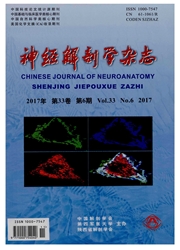

 中文摘要:
中文摘要:
目的:探讨sonic hedgehog/Gli1(Shh/Gli1)信号在小鼠脊髓损伤后病理变化及运动功能恢复中的作用。方法:成年雄性C57野生型、Gli1^lz和Gli1^lz/lz小鼠行T8节段脊髓夹伤及假手术。Gli1^lz小鼠脊髓损伤及假手术后3 d行X-gal染色;7 d行Shh/PDGFr-α、Shh/GFAP、LacZ/GFAP染色,观察Shh/Gli1信号在小鼠脊髓损伤后的激活。C57野生型和Gli1^lz/lz小鼠脊髓夹伤后7 d行GFAP染色和实时定量RT-PCR,观察星形胶质细胞反应;术后14 d尾静脉注射伊文氏兰观察血-脊髓屏障改变;术后1、3、5 d和7 d行BMS评分评价小鼠后肢运动功能。结果:脊髓损伤7 d后,损伤区Shh表达升高;Shh/Gli1信号报告基因LacZ表达升高,主要表达于反应性星形胶质细胞;免疫组织化学及实时定量RT-PCR结果显示Gli1基因敲除不影响脊髓损伤后GFAP表达;伊文氏兰染色及其定量分析显示Gli1^lz/lz小鼠脊髓损伤后脊髓组织伊文氏兰外渗增加。BMS评分显示Gli1^lz/lz小鼠运动功能恢复显著差于野生型小鼠。结论:Shh/Gli1信号在小鼠脊髓损伤后激活,可能参与脊髓损伤后血-脊髓屏障渗透性的改变,并影响脊髓损伤后的运动功能恢复。
 英文摘要:
英文摘要:
Objective: To explore the roles of sonic hedgehog/Glil (Shh/Glil) signaling in the pathological changes and locomotion recovery after spinal cord injury (SCI) in mice. Methods: Adult male wild type, Glil^lz and Glil^lz/lz mice were adopted for spinal cord contusion or sham operation. For detecting the Shh/Glil signaling after SCI, X-gal staining was conducted 3 days post-injury, and double-immunostaining of Shh/PDGFr-α, Shh/GFAP and LacZ/GFAP at 7 days post-injury on Glil^lz mice. To explore the effects of Glil mutation on SCI, the expression of GFAP, and the intra-paren- chymal Eevens Blue were examined 7 days and 14 days respectively after SCI in Glil^lz/lz mice. Furthermore, locomotion recovery was assessed by the BMS scoring at 1, 3, 5 and 7 days post-injury in Glil^lz/lz mice. Results: Seven days after SCI, the expression of Shh and LacZ was increased, mainly in the lesion area and reactive astrocyte, respectively. Immunohistochemistry and real-time RT-PCR showed that Gli! mutation did not affect the expression of GFAP. Evens Blue stai- ning and its quantification showed that the leakage of Evens Blue was prolonged in the Glil^lz/lz mice after SCI. BMS scoring showed that the locomotion recovery of Glil^lz/lz mice was much poorer than that of wild type control. Conclusion:Shh/ Glil signaling is activated after SCI, probably involved in the permeability of blood spinal cord barrier and the locomotion recovery after SCI.
 同期刊论文项目
同期刊论文项目
 同项目期刊论文
同项目期刊论文
 期刊信息
期刊信息
